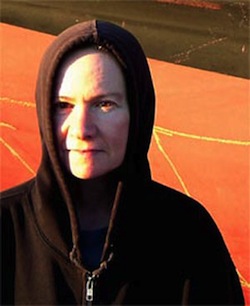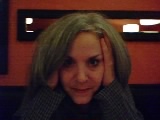
| Jacket 40 — Late 2010 | Jacket 40 Contents | Jacket Homepage | Search Jacket |
This piece is about 3 printed pages long.
It is copyright © Bobbi Lurie and Jacket magazine 2010. See our [»»] Copyright notice.
The Internet address of this page is http://jacketmagazine.com/40/r-greenstreet-rb-lurie.shtml
Kate Greenstreet
The last 4 Things
reviewed by
Bobbi Lurie
Ahsahta Press, ISBN-13 978–1-934103–09-8, 104 pages 6” x 8” US$19.00

Kate Greenstreet
1
The strongest part of Kate Greenstreet’s second poetry collection, The Last 4 Things, is the first section and title poem of the book. I personally would have preferred to see this long, intriguingly beautiful, fractured and fragmented poem extended into a single poem and made into a book on its own. On the first page, a single line, in italics, set apart from the other fonts and stanzas gives a sense of the spiritual, the other-worldly which poetry, at its best, and Greenstreet, at her best, is able to do:
2
I have had a Letter from another World…
3
This Letter, this World, the sparks of disconnected thoughts depicted through the poet’s phrasing, the flashes of wisdom and the structure of this first section, with its blank pages and spaces is symbolic of her trust in silence and space as a poetic device. Her writing is unique, fragmented, unclear, as if she is content to stay in her own world, as if the imaginary reader does not exist in the scheme of things. This creates a strange sense of intimacy since it feels as if we are being told a series of secrets or whisperings accidentally overheard. There is a religious element as well in what she writes:
4
There’s a hole
in the middle of life (the body).
The flashbacks will remind us.
Set down. To write.
Or copy, to consider.
To humiliate or humble, set down in heavy fog.
To cause to pass into the given,
to set a prisoner free.
5
The second section of the book, 56 Days, maintains Greenstreet’s mysterious style of writing but it is arranged in a way which contradicts the lack of coherence which made the first section so strong. Each entry is given a date and a single page, reminiscent of a diary. Greenstreet’s fragmentations do not belong within this framework especially in contrast to the first section of the book. The only believable aspect of this section being a diary was that it reflected what would be an actual person’s inability to keep up with daily entries. The title which indicated the writing took place over 56 days was pared down to 31 entries. Yet it did not feel like a diary in that it was impossible to sense the presence of a single person. Regardless of who was speaking, without getting into a discussion re: the I, there are some notable passages. For example, the entry on January 14:
6
He gets to know the room. So he can navigate it when his sight is gone. A guard for what the bare hand should not touch. To be human? You have to keep doing it. You can never see what things are made of. And it’s all so hard to believe in — you know… atoms? You’re just here, out of nowhere. Then you go back into nowhere. And even every night you beg to go back. Just to make it stop for a while. Even though all you really want to do is stick around. That’s what it’s like.
7
A DVD is included in this collection and it, too, is divided into two parts, one for each section of the book. The video made for The Last 4 Things was definitely the stronger of the two. At the end of the DVD Greenstreet titles these “video experiments” and they certainly are that. There is a daring willingness to explore in this DVD. Photographic negatives, split screens with the author reading in some, the use of both of black and white film as well as color, sharply defined images as well as blurry ones, the use of silence and music and speech and sounds all serve to exemplify Greenstreet as an artist deeply involved in process. My one problem with this portion of the DVD was a section which used a projector, along with its clicking sound, along with lines of writing from the book. These shots and clicks of the projector felt disconnected from the poetry as did some of the music in both sections of the DVD. My confusions about 56 Days were not helped by the section of the DVD titled for this part of the book though I did gain clarity of the entire section in an interview on the author’s web site.
8
Normally, when reviewing a new poetry collection, I would prefer not to read an author’s web site since they are created as promotional tools. Kate Greenstreet’s book cover, however, made this an exception. Her book cover, at its best, might be seen as a luminous view of the grooves of a DVD presenting a simplicity reminiscent of an Agnes Martin painting. Kate Greenstreet’s name and the title of the book are almost invisibly placed at the side on the bottom of the front cover. In contrast, in the center of the back cover are the words “SEE ALSO KICKINGWIND.COM.” I followed the command. This web site is beautifully done but I wish Greenstreet had put the address of her web site inside the book instead.
9
Reading the web site was a distraction and did more to detract than enhance my reading of the actual book or viewing the DVD in spite of the fact that it helped me understand the intention of 56 Days. But had I not read the author’s web site I would have written that the DVD was an extension of the book since the word camera and the fragmented references to photography (one entry was quite literal and specific) were prevalent throughout the book. The book, in fact, ends with the words:
10
Someone was there to take a picture.
11
My favorite lines written by Greenstreet (in the first section of the book, on the first page) re: the camera were:
12
Empathy is marked with
incomprehensible corrections. The camera must be open.

Bobbi Lurie
Bobbi Lurie’s third poetry collection, Grief suite, will be published by CW Books in May, 2010. Her other collections are The Book I Never Read and Letter from the Lawn.